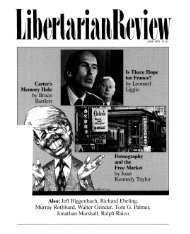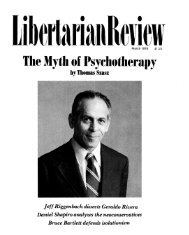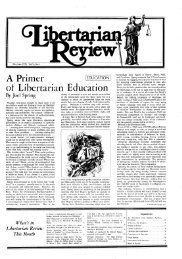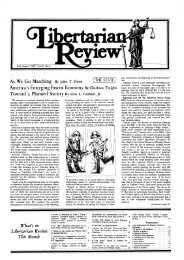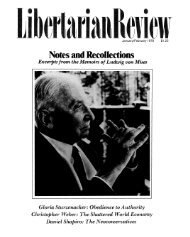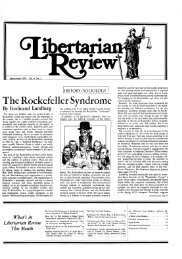The Libertarian Review July 1978 - Libertarianism.org
The Libertarian Review July 1978 - Libertarianism.org
The Libertarian Review July 1978 - Libertarianism.org
Create successful ePaper yourself
Turn your PDF publications into a flip-book with our unique Google optimized e-Paper software.
present-day India. In 1975, IndiraGhandi imposed a two-year dictatorshipupon the country. Civil liberties weresuspended and many intellectuals weretossed into prison. During these twoyears, the economy experienced ahealth and growth unprecedented inher history. This puzzled most Westernobservers, some of whom began to questionwhether dictatorship wasn't reallythe best way to make an economy work.This mystery is solved, however, whenwe observe the actions of the financeminister at that time, one C.Subramaniam. He used the suspensionof parliamentary activity to pushthrough his ideas of tax-cutting. <strong>The</strong>12.5 percent surtax was abolished, aswas a seven percent "urban-property"wealth tax; the "regular" wealth tax wasslashed from eight percent to 2.5 percent;the maximum tax rate waslowered from 85 percent to 77 percent,and then to 66 percent-with lowerbrackets being likewise adjusted. Corporatetaxes were also cut, and the progressivetax system on investment androyalty was scrapped in favor of a proportionalset-up.Not unexpectedly, the rupee rose onexchange markets; price inflation wassliced by two-thirds; bumper cropscame in from the farms; in short, thechronically ill Indian economy enjoyeda respite of health. Mrs. Ghandi'spopularity rose with the economy; butsince she believed that it was by her ownstrong statist fist that improvementcame, she began to trample on individuallibertyright and left. With thecoercive sterilization episode, the electoratefinally rose up against her. Shewent down to defeat, never understandingthat it was her (unwittingly) libertarianactions that gained her popularity'not her dictatorial ones.Wanniski's examples go on and on.For them alone, his book is worthreading. <strong>The</strong>y make up the finest partsof his work.Unfortunately, I believe there to beflawed parts in it as well, flaws quiteapart from his enthusiasm for the LafferCurve. For example, Wanniski has theidea that the electorate is always right,that it understands economics, and thatit knows what it wants-such as lowertaxes - and will wait patiently untilpolitical leaders give it to them. Heholds that great ideas are not "sold" tothe people; rather, they are ideas "thatthe electorate craves even prior to theirconception." I believe the influence ofsuch opinion molders as philosophers,cultural and religious leaders, andmedia men to be much greater thandoes Wanniski. It was, for instance, thepolitical philosophy of John Locke,popularized by the journalists JohnTrenchard and Thomas Gordon, alongwith Thomas Paine, who moved thehearts and minds of the Americancolonists and gave direction torebellious sentiments.It is one thing to saythat higher taxes andtariffs produce ill,but quite another toill1pute All1erica'sGreat Depressionto a tariff. Yet that isjust what Wanniskidoes in his book.theirWanniski has a strange idea ofcapital. He holds that "all 'wealth'capable of producing goods and services"should be counted as capital. Notonly financial wealth is capital, butwhatever makes people feel good andthus makes them produce. "As long aspeople get pleasure from gazing on theMona Lisa, it is capital. Clean air andwater are capital. A Beethoven symphonyand a rock tune are capital.Parks, statues, buildings, houses, sewerlines, waterworks, all are capital." Thisdefinition, however, breaks up theuniversality of the concept of capital.<strong>The</strong> old view holds that capital is allresources which are not themselves consumed,but used to create goods thatare. <strong>The</strong>y are of at least potential valueto all people. But things like a "rocktune" are not. (<strong>The</strong>re are some peopleto whom this would be entirely withoutvalue.) Further, there are no limits tothis subjective view of capital other thanabsurdity itself. If contemplating mynavel helps me produce, is that navelcapital?This said, Wanniski goes on to makean excellent point: In the various aggregatemeasurements that governmenteconomists make, there are so manyvalues that.can't be measured that theofficial reckonings are never accurate.But here I would draw the distinctionbetween the subjective values of individualsand the objective "capitalgoods." He puts a greater burden on hisanalysis than it can bear. It is one thingto say that higher taxes and tariffs produceill, but quite another to impute theGreat Depression to a tariff. Yet that iswhat he does. <strong>The</strong> boom was caused bythe lowering of the war-tax rates in1921. <strong>The</strong> 77 percent maximum taxrate of the war years gave way to a 46percent rate. <strong>The</strong> excess-profits tax waseliminated. <strong>The</strong>re was explosiveeconomic growth during the 1920s as aresult of this, he claims. And then, "<strong>The</strong>stock market crash of 1929 and theGreat Depression ensued because of thepassage of the Smoot-Hawley Tariff Actof 1930." Specifically it was the market'sexpectation of the tariff bill that causedthe crash, and the evils of the tariff itselfthat dragged it out into the Depression.Admittedly, Smoot-Hawley wasprobably the worst tariff act in anAmerican history filled with tariff acts.But the Depression was not caused bythis. It was caused by the inflation of the1920s, as Murray Rothbard has brilliantlyshown in his America's GreatDepression. Wanniski finds fault withall the conventional explanations of theDepression-and rightly so, for all butthe Austrian view. But when he attacksRothbard's book, he is wrong. Rothbard,he says, "reckons the expansionfrom 1921-1929 as an 'inflationaryboom' [where] the money supply ... increasedby 61.8 percent over the eightyears. His America's Great Depressionseems untroubled by thefall in the consumerprice index over eight years, from53.6 to 51.3." But Rothbard has indeeddealt with this. He begins page 82 ofAmerica's Great Depression with this:"[T]he designation of the 1920s as aperiod of inflationary boom may troublethose who think of inflation as a risein prices. Prices generally remainedstable and even fell slightly over theperiod. But we must realize that twogreat forces were at work on prices duringthe 1920's-the monetary inflation38<strong>July</strong> <strong>1978</strong>



